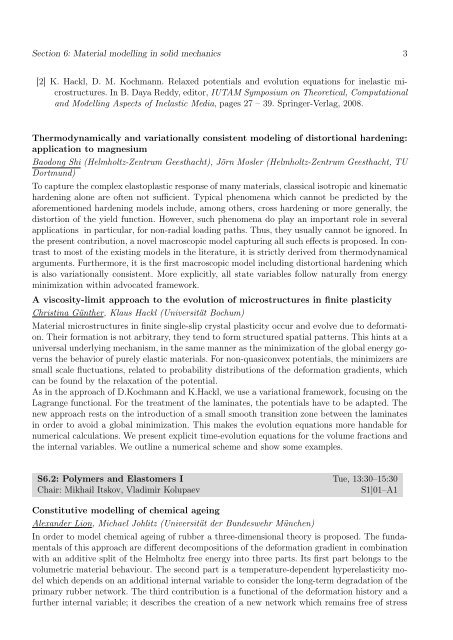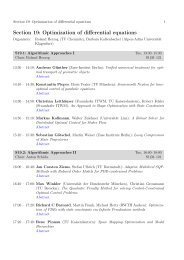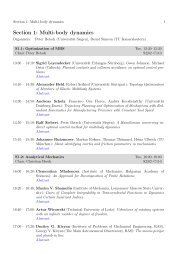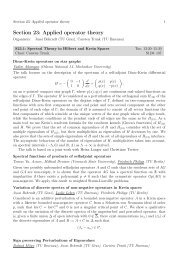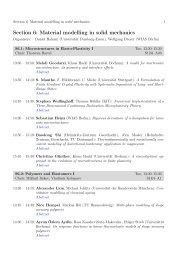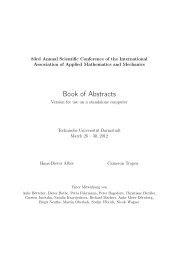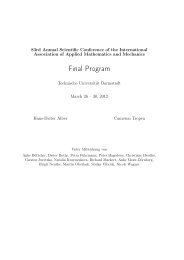Section 6: Material modelling in solid mechanics - GAMM 2012
Section 6: Material modelling in solid mechanics - GAMM 2012
Section 6: Material modelling in solid mechanics - GAMM 2012
Create successful ePaper yourself
Turn your PDF publications into a flip-book with our unique Google optimized e-Paper software.
<strong>Section</strong> 6: <strong>Material</strong> <strong>modell<strong>in</strong>g</strong> <strong>in</strong> <strong>solid</strong> <strong>mechanics</strong> 3<br />
[2] K. Hackl, D. M. Kochmann. Relaxed potentials and evolution equations for <strong>in</strong>elastic microstructures.<br />
In B. Daya Reddy, editor, IUTAM Symposium on Theoretical, Computational<br />
and Modell<strong>in</strong>g Aspects of Inelastic Media, pages 27 – 39. Spr<strong>in</strong>ger-Verlag, 2008.<br />
Thermodynamically and variationally consistent model<strong>in</strong>g of distortional harden<strong>in</strong>g:<br />
application to magnesium<br />
Baodong Shi (Helmholtz-Zentrum Geesthacht), Jörn Mosler (Helmholtz-Zentrum Geesthacht, TU<br />
Dortmund)<br />
To capture the complex elastoplastic response of many materials, classical isotropic and k<strong>in</strong>ematic<br />
harden<strong>in</strong>g alone are often not sufficient. Typical phenomena which cannot be predicted by the<br />
aforementioned harden<strong>in</strong>g models <strong>in</strong>clude, among others, cross harden<strong>in</strong>g or more generally, the<br />
distortion of the yield function. However, such phenomena do play an important role <strong>in</strong> several<br />
applications <strong>in</strong> particular, for non-radial load<strong>in</strong>g paths. Thus, they usually cannot be ignored. In<br />
the present contribution, a novel macroscopic model captur<strong>in</strong>g all such effects is proposed. In contrast<br />
to most of the exist<strong>in</strong>g models <strong>in</strong> the literature, it is strictly derived from thermodynamical<br />
arguments. Furthermore, it is the first macroscopic model <strong>in</strong>clud<strong>in</strong>g distortional harden<strong>in</strong>g which<br />
is also variationally consistent. More explicitly, all state variables follow naturally from energy<br />
m<strong>in</strong>imization with<strong>in</strong> advocated framework.<br />
A viscosity-limit approach to the evolution of microstructures <strong>in</strong> f<strong>in</strong>ite plasticity<br />
Christ<strong>in</strong>a Günther, Klaus Hackl (Universität Bochum)<br />
<strong>Material</strong> microstructures <strong>in</strong> f<strong>in</strong>ite s<strong>in</strong>gle-slip crystal plasticity occur and evolve due to deformation.<br />
Their formation is not arbitrary, they tend to form structured spatial patterns. This h<strong>in</strong>ts at a<br />
universal underly<strong>in</strong>g mechanism, <strong>in</strong> the same manner as the m<strong>in</strong>imization of the global energy governs<br />
the behavior of purely elastic materials. For non-quasiconvex potentials, the m<strong>in</strong>imizers are<br />
small scale fluctuations, related to probability distributions of the deformation gradients, which<br />
can be found by the relaxation of the potential.<br />
As <strong>in</strong> the approach of D.Kochmann and K.Hackl, we use a variational framework, focus<strong>in</strong>g on the<br />
Lagrange functional. For the treatment of the lam<strong>in</strong>ates, the potentials have to be adapted. The<br />
new approach rests on the <strong>in</strong>troduction of a small smooth transition zone between the lam<strong>in</strong>ates<br />
<strong>in</strong> order to avoid a global m<strong>in</strong>imization. This makes the evolution equations more handable for<br />
numerical calculations. We present explicit time-evolution equations for the volume fractions and<br />
the <strong>in</strong>ternal variables. We outl<strong>in</strong>e a numerical scheme and show some examples.<br />
S6.2: Polymers and Elastomers I Tue, 13:30–15:30<br />
Chair: Mikhail Itskov, Vladimir Kolupaev S1|01–A1<br />
Constitutive <strong>modell<strong>in</strong>g</strong> of chemical age<strong>in</strong>g<br />
Alexander Lion, Michael Johlitz (Universität der Bundeswehr München)<br />
In order to model chemical age<strong>in</strong>g of rubber a three-dimensional theory is proposed. The fundamentals<br />
of this approach are different decompositions of the deformation gradient <strong>in</strong> comb<strong>in</strong>ation<br />
with an additive split of the Helmholtz free energy <strong>in</strong>to three parts. Its first part belongs to the<br />
volumetric material behaviour. The second part is a temperature-dependent hyperelasticity model<br />
which depends on an additional <strong>in</strong>ternal variable to consider the long-term degradation of the<br />
primary rubber network. The third contribution is a functional of the deformation history and a<br />
further <strong>in</strong>ternal variable; it describes the creation of a new network which rema<strong>in</strong>s free of stress


